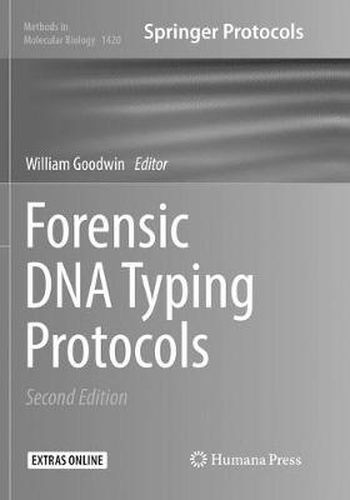Readings Newsletter
Become a Readings Member to make your shopping experience even easier.
Sign in or sign up for free!
You’re not far away from qualifying for FREE standard shipping within Australia
You’ve qualified for FREE standard shipping within Australia
The cart is loading…






This title is printed to order. This book may have been self-published. If so, we cannot guarantee the quality of the content. In the main most books will have gone through the editing process however some may not. We therefore suggest that you be aware of this before ordering this book. If in doubt check either the author or publisher’s details as we are unable to accept any returns unless they are faulty. Please contact us if you have any questions.
This volume presents a series of protocols and methods, some of which are not widely used by researchers/practitioners, and will aid in the execution of different laboratory techniques. Forensic DNA Typing Protocols, Second Edition is arranged into a series of related chapters. Chapter 1-3 examines two different aspects of RNA analysis for body fluid identification. Chapters 4-7 focuses on the storage of biological materials and the extraction of DNA from hard tissues. Chapters 8-10 present methods for monitoring the quality of DNA extracts, and steps to aid in the purification of DNA. Chapters 11-16 talk about methods on non-standard markers, such as INDELs, Y chromosome STRs, and mitochondrial DNA. Detailed procedures and data analysis for phenotypes and ancestry are explored in Chapter 17-19. The last chapter (20) looks at the application of DNA typing to the identification of non-human material to species level. Written in the highly successful Methods in Molecular Biology series format, chapters include introductions to their respective topics, lists of the necessary materials and reagents, step-by-step, readily reproducible laboratory protocols, and tips on troubleshooting and avoiding known pitfalls.
Practical and thorough, Forensic DNA Typing Protocols, Second Edition, is a valuable resource for forensic specialists, researchers, and anyone interested in the field of forensic science.
$9.00 standard shipping within Australia
FREE standard shipping within Australia for orders over $100.00
Express & International shipping calculated at checkout
This title is printed to order. This book may have been self-published. If so, we cannot guarantee the quality of the content. In the main most books will have gone through the editing process however some may not. We therefore suggest that you be aware of this before ordering this book. If in doubt check either the author or publisher’s details as we are unable to accept any returns unless they are faulty. Please contact us if you have any questions.
This volume presents a series of protocols and methods, some of which are not widely used by researchers/practitioners, and will aid in the execution of different laboratory techniques. Forensic DNA Typing Protocols, Second Edition is arranged into a series of related chapters. Chapter 1-3 examines two different aspects of RNA analysis for body fluid identification. Chapters 4-7 focuses on the storage of biological materials and the extraction of DNA from hard tissues. Chapters 8-10 present methods for monitoring the quality of DNA extracts, and steps to aid in the purification of DNA. Chapters 11-16 talk about methods on non-standard markers, such as INDELs, Y chromosome STRs, and mitochondrial DNA. Detailed procedures and data analysis for phenotypes and ancestry are explored in Chapter 17-19. The last chapter (20) looks at the application of DNA typing to the identification of non-human material to species level. Written in the highly successful Methods in Molecular Biology series format, chapters include introductions to their respective topics, lists of the necessary materials and reagents, step-by-step, readily reproducible laboratory protocols, and tips on troubleshooting and avoiding known pitfalls.
Practical and thorough, Forensic DNA Typing Protocols, Second Edition, is a valuable resource for forensic specialists, researchers, and anyone interested in the field of forensic science.